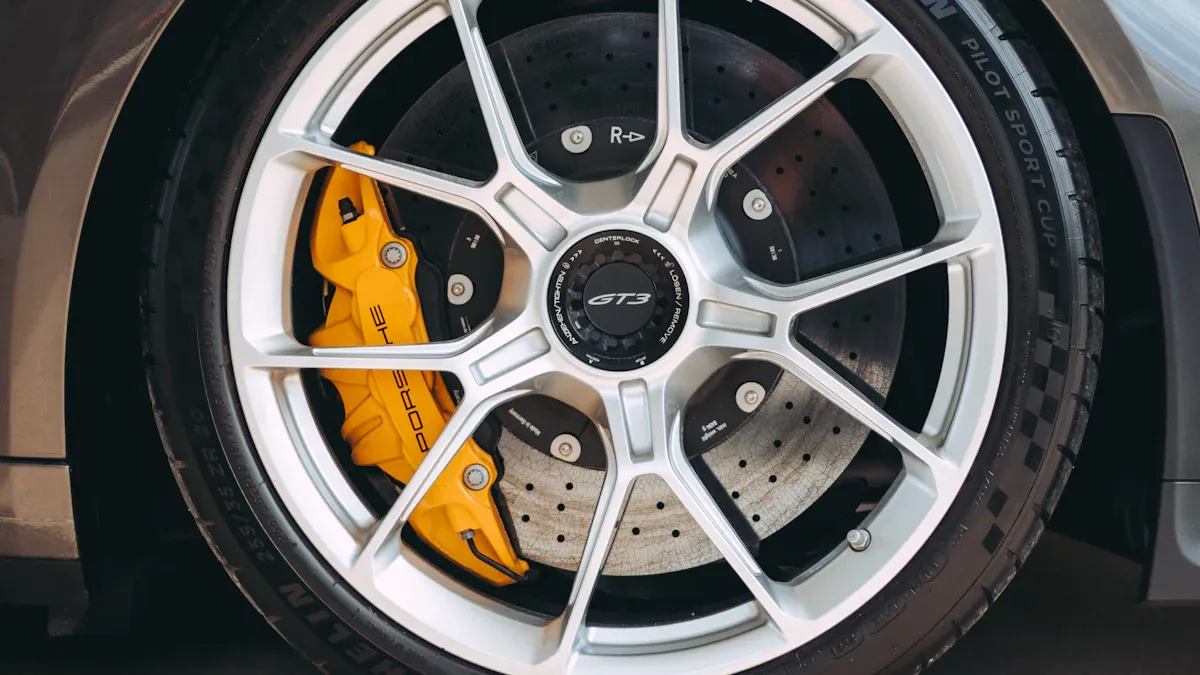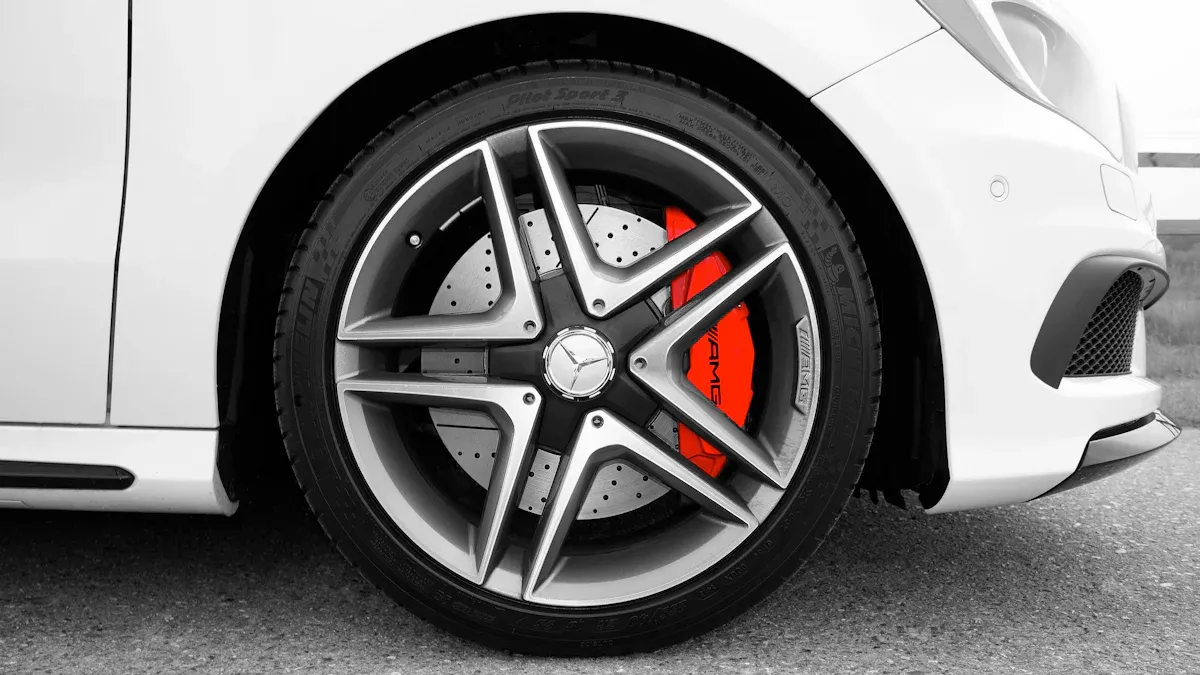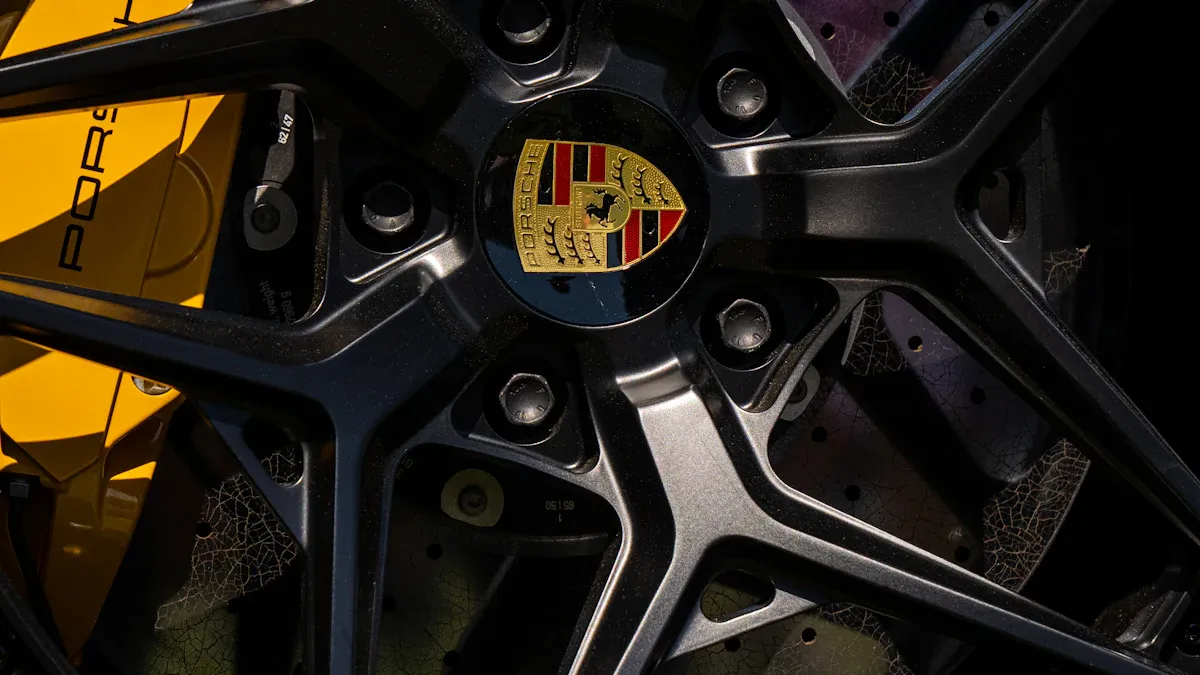

fortuneau
May 15, 2025
Types of Clip Wheel Weights Explained

Clip-on weights play a crucial role in maintaining your vehicle’s performance. These small yet essential components help balance your tires, ensuring a smoother ride and reducing uneven wear. Properly balanced tires improve fuel efficiency, enhance safety, and extend tire lifespan.
The importance of clip-on weights is evident in their market growth. By 2025, the global clip-on balance weight market is expected to reach $367 million, with a steady annual growth rate of 4.3% until 2033. This rise reflects the growing demand for automotive safety, fuel efficiency, and advancements in wheel balancing technology.
Choosing the right clip wheel weights can significantly improve your vehicle’s stability. Whether you drive on highways or rugged terrains, balanced tires provide better control and minimize vibrations, giving you a more comfortable driving experience.
What Are Clip-On Weights?

Purpose and Functionality of Clip-On Weights
Clip-on weights are small, precision-engineered components designed to balance your vehicle’s wheels. When a tire rotates, even minor weight imbalances can cause vibrations, uneven wear, and reduced fuel efficiency. Clip-on weights counteract these imbalances by adding the exact amount of weight needed to restore balance. This ensures smoother rides, better handling, and longer tire life.
One of the key advantages of clip-on weights is their adaptability. These weights come in customizable lengths, allowing you to cut them to fit specific requirements. This flexibility enhances balance accuracy and reduces the need for multiple weight sizes. Additionally, clip-on weights support automated tire balancing processes, making them ideal for modern production lines. Here’s a quick overview of their performance metrics:
| Performance Metric | Description |
|---|---|
| Customizable Lengths | Clip-on weights can be cut to size for specific requirements, enhancing balance accuracy. |
| Simplified Inventory | One product replaces multiple sizes, reducing the complexity and cost of inventory management. |
| Automation Capability | Supports automated tire balancing processes, improving efficiency and speed in production. |
By using clip-on weights, you can ensure your vehicle operates at peak performance, whether you’re driving on city streets or rugged terrain.
Common Applications for Clip-On Weights in Vehicles and Equipment
Clip-on weights are widely used across various industries due to their versatility and effectiveness. In the automotive sector, they are essential for balancing wheels, with over 65% of global clip-on weight usage attributed to vehicles. On average, 5-8 weights are applied per wheel, contributing to the production of 80 million vehicles annually.
Beyond cars, clip-on weights play a critical role in aerospace, industrial machinery, and even consumer appliances. For example, an Airbus A320 engine fan blade may require up to 120 weights for proper balance. In industrial settings, a 2.5 MW turbine rotor uses 80-100 weights to counteract aerodynamic imbalances. Even household items like washing machines rely on clip-on weights, with 15-20 weights used per drum assembly to ensure smooth operation.
Here’s a breakdown of their applications:
| Application Area | Quantitative Evidence |
|---|---|
| Automotive | Over 65% of global clip-on balance weight usage; 5-8 weights per wheel for 80 million vehicles produced annually. |
| Aerospace | Up to 120 weights required for balancing a single Airbus A320 engine fan blade. |
| Industrial Machinery | 80-100 weights used in a 2.5 MW turbine rotor to counteract aerodynamic imbalances. |
| Consumer Appliances | 15-20 weights per washing machine drum assembly; 150 million units sold annually. |
| Agricultural Equipment | John Deere’s S700 Series Combines reduce grain loss by up to 12% with modular clip-on weight systems. |
| Medical Imaging | Each 3T MRI scanner uses 200-300 micro-weights calibrated to 0.01g precision. |
Whether you’re balancing a car tire or a turbine rotor, clip-on weights ensure stability and efficiency across a wide range of applications.
Different Types of Clip-On Weights

When it comes to balancing your vehicle’s wheels, understanding the different types of clip-on weights is essential. Each material offers unique benefits, making it suitable for specific applications. Let’s explore the most common options: lead, zinc, and steel.
Lead Clip-On Weights: Characteristics and Uses
Lead clip-on weights have been a staple in the automotive industry for decades due to their high density and malleability. These weights are compact yet effective, requiring less material to achieve the desired balance. Their softness makes them easy to install and adjust, even on uneven wheel surfaces.
However, environmental concerns have led to significant changes in their usage. Many regions, including the European Union, have restricted or prohibited lead weights due to their toxicity. In fact, lead weights banned in the EU have prompted manufacturers to explore alternative materials. Despite this, lead weights remain popular in some markets where regulations are less stringent. If you’re considering lead weights, ensure they comply with local environmental standards.
Zinc Clip-On Weights: Advantages and Limitations
Zinc clip-on weights are a modern alternative to lead. They offer several advantages that make them a preferred choice for many vehicle owners and manufacturers:
- Zinc weights are malleable, similar to lead, which simplifies installation and removal.
- They provide a contoured appearance on the wheel, enhancing the overall aesthetic.
- Zinc is widely used by OEMs, reflecting its popularity in the automotive industry.
From a performance perspective, zinc weights deliver reliable results. They balance wheels effectively, ensuring smoother rides and reduced tire wear. However, environmental concerns still exist. While zinc poses less risk than lead, some states, like Maine, have raised concerns about its impact on wildlife. On the other hand, states like Ohio have adopted zinc-coated steel weights to mitigate these issues.
The global wheel balancing weights market, projected to reach $750 million, highlights the growing demand for sustainable materials. Zinc weights play a significant role in this shift, offering up to 40% less environmental impact compared to lead. If you’re looking for a balance between performance and sustainability, wheel weights made of zinc are an excellent choice.
Steel Clip-On Weights: Durability and Applications
Steel clip-on weights have gained popularity as a durable and eco-friendly option. Unlike lead or zinc, steel is highly resistant to wear and tear, making it ideal for vehicles that operate in harsh conditions. Whether you’re driving on rugged terrains or through extreme weather, steel weights maintain their integrity.
From a sustainability standpoint, steel aligns with circular economy principles. These weights are fully recyclable, reducing waste and promoting environmental responsibility. The shift from lead to steel reflects a broader commitment to sustainability in the automotive industry. Additionally, steel weights are compatible with adhesive wheel weights, offering versatility in wheel balancing solutions.
Performance-wise, steel weights excel in durability. They withstand various operational conditions without compromising balance. This makes them a reliable choice for both personal vehicles and heavy-duty equipment. If you prioritize longevity and environmental impact, steel clip-on weights are worth considering.
Plastic/Steel Hybrid Clip-On Weights: A Modern Alternative
Plastic/steel hybrid clip-on weights represent a cutting-edge solution in wheel balancing technology. These weights combine the durability of steel with the lightweight and corrosion-resistant properties of plastic. This innovative design offers several advantages, making them a popular choice for modern vehicles and equipment.
Why Choose Plastic/Steel Hybrid Weights?
Hybrid weights provide a unique balance of performance and sustainability. Here’s why they stand out:
- Enhanced Corrosion Resistance: The plastic coating protects the steel core from rust, ensuring long-lasting performance even in harsh environments.
- Lightweight Design: The plastic component reduces overall weight, which minimizes the impact on fuel efficiency.
- Eco-Friendly Materials: Manufacturers often use recyclable plastics and steel, aligning with global sustainability goals.
Tip: If you frequently drive in areas with high humidity or road salt exposure, hybrid weights can help prevent corrosion and maintain wheel balance over time.
Applications and Benefits
Plastic/steel hybrid weights excel in various applications, from passenger vehicles to heavy-duty machinery. Their versatility makes them suitable for aluminum and steel rims alike.
| Feature | Benefit |
|---|---|
| Corrosion Resistance | Protects against rust, extending the lifespan of the weights. |
| Lightweight Construction | Reduces strain on wheels, improving fuel efficiency. |
| Aesthetic Appeal | Offers a sleek appearance that complements modern wheel designs. |
| Environmental Sustainability | Supports recycling initiatives and reduces environmental impact. |
You’ll find these weights particularly useful for vehicles operating in extreme weather conditions. Their durability ensures consistent performance, whether you’re navigating snowy roads or sandy terrains.
How Do Hybrid Weights Compare to Other Types?
Plastic/steel hybrid weights outperform traditional materials in several key areas:
- Durability: Steel provides unmatched strength, while the plastic coating prevents wear and tear.
- Safety: The hybrid design minimizes the risk of detachment, ensuring secure wheel balance.
- Adaptability: These weights fit a wide range of rim types, making them a versatile choice for different vehicles.
While lead and zinc weights have dominated the market for years, hybrid weights offer a modern alternative that prioritizes both performance and environmental responsibility.
Are Hybrid Weights Right for You?
If you value durability, sustainability, and aesthetic appeal, plastic/steel hybrid weights are an excellent choice. They cater to drivers who want reliable wheel balancing without compromising on eco-friendliness.
Note: Always check compatibility with your vehicle’s rims before purchasing hybrid weights. Consult your mechanic or manufacturer for guidance.
Plastic/steel hybrid clip-on weights represent the future of wheel balancing. By choosing these innovative weights, you can enjoy improved performance, longer lifespan, and a reduced environmental footprint.
Practical Uses of Clip-On Weights
Best Clip-On Weights for Aluminum Rims
Aluminum rims are lightweight and stylish, making them a popular choice for modern vehicles. However, their unique properties require specific clip-on weights to ensure proper balance and performance. Steel and plastic/steel hybrid clip-on weights are often the best options for aluminum rims. These materials provide durability and corrosion resistance, which are essential for maintaining the integrity of aluminum wheels.
Steel clip-on weights are particularly effective due to their strength and recyclability. They offer a secure fit, even on high-performance vehicles. On the other hand, plastic/steel hybrid weights combine the strength of steel with the lightweight and rust-resistant properties of plastic. This makes them ideal for drivers who frequently encounter wet or salty road conditions.
Balancing all wheel positions, including trailer tires, has been documented to increase fuel economy by 1% to 2%. Well-balanced wheel assemblies can increase safety and comfort for heavy-duty truckers while decreasing fuel costs. Internal compounds are a viable alternative to heavy-duty balancing, but external weight balancing is the best option for constant balance.
When selecting clip-on weights for aluminum rims, always consider the material’s compatibility with your wheels. Properly balanced aluminum rims not only enhance your vehicle’s appearance but also improve fuel efficiency and driving comfort.
Best Clip-On Weights for Steel Rims
Steel rims are known for their durability and affordability, making them a common choice for heavy-duty vehicles and off-road applications. Zinc weights for steel rims are a popular option due to their malleability and ability to provide a snug fit. These weights are easy to install and remove, ensuring a hassle-free balancing process.
Steel clip-on weights are another excellent choice for steel rims. Their robust construction makes them resistant to wear and tear, even in challenging environments. These weights are fully recyclable, aligning with sustainability goals while offering long-lasting performance.
For vehicles operating in extreme conditions, plastic/steel hybrid weights can also be a viable option. Their corrosion-resistant properties protect steel rims from rust, extending the lifespan of both the weights and the wheels. By choosing the right clip-on weights for steel rims, you can ensure optimal performance and reduce the risk of improper tractor balancing, which can lead to uneven tire wear and decreased efficiency.
How to Use Tractor Wheel Weights for Stability and Performance
Tractor wheel weights play a crucial role in enhancing the stability and performance of agricultural equipment. These weights are designed to counterbalance the heavy machinery, ensuring smooth operation and reducing the risk of tipping over. Knowing how to use tractor wheel weights effectively can significantly improve your tractor’s efficiency.
To install tractor wheel weights, start by determining the appropriate weight for your equipment. This depends on the type of tractor and the tasks it performs. Attach the weights securely to the wheels, ensuring they are evenly distributed. Uneven weight distribution can lead to improper tractor balancing, which affects stability and increases wear and tear.
The benefits of using tractor wheel weights are substantial. They improve traction, especially on uneven or slippery surfaces, and reduce rolling resistance, leading to better fuel efficiency. Additionally, they minimize vibrations, extending the lifespan of your tractor and its components.
| Benefit | Description |
|---|---|
| Enhanced performance | Improves traction, stability, and overall efficiency. |
| Longevity of equipment | Minimizes wear and tear, reducing vibration and extending lifespan. |
| Fuel efficiency | Reduces rolling resistance, leading to smoother operation and less fuel use. |
| Cost savings | Lowers maintenance costs and improves fuel efficiency for long-term savings. |
By understanding how to use tractor wheel weights, you can maximize your equipment’s potential. Whether you’re plowing fields or hauling heavy loads, these weights ensure your tractor operates safely and efficiently.
Benefits of Using Clip-On Weights
Cost-Effectiveness and Long-Term Savings
Clip-on weights offer significant cost savings over time. By ensuring even distribution of weight across your vehicle’s wheels, they reduce uneven tire wear. This prolongs tire lifespan and minimizes replacement costs. Balanced tires also improve fuel efficiency, which lowers your expenses at the pump.
Investing in durable clip-on weights means fewer replacements. Steel weights, for example, last longer due to their resistance to wear and tear. This durability translates into fewer maintenance costs, saving you money in the long run.
Tip: Monitor performance regularly to ensure your clip-on weights remain securely attached. This simple step prevents imbalances that could lead to costly repairs.
Choosing the right clip-on weights not only enhances performance but also delivers long-term financial benefits. Whether you drive a passenger car or operate heavy machinery, these weights help you achieve better performance while keeping your budget in check.
Durability Across Different Terrains
Clip-on weights excel in durability, making them suitable for various terrains. Steel weights, in particular, withstand harsh conditions like rugged roads and extreme weather. Their robust construction ensures they stay intact, even during demanding operations.
Plastic/steel hybrid weights offer added corrosion resistance, making them ideal for areas with high humidity or road salt exposure. These weights maintain their integrity, ensuring consistent wheel balance and enhanced performance.
For off-road vehicles or agricultural equipment, durable weights improve traction and stability. They reduce vibrations, which protects your vehicle’s components and extends its lifespan. Whether you’re navigating rocky trails or muddy fields, clip-on weights ensure your vehicle performs reliably.
Environmental Considerations and Material Choices
Selecting the right material for clip-on weights impacts the environment. Steel stands out as the most eco-friendly option due to its recyclability and low toxicity. Zinc offers flexibility and durability, making it a viable alternative to steel. Lead, while effective, poses high toxicity risks and has been banned in many regions.
| Material | Environmental Benefit | Notes |
|---|---|---|
| Lead | High toxicity | Banned in many regions |
| Steel | Recyclable, lower toxicity | Most eco-friendly option |
| Zinc | Flexible, durable | Viable alternative to steel |
By choosing sustainable materials like steel or zinc, you contribute to global efforts to reduce environmental impact. These materials align with recycling initiatives, promoting a circular economy.
Note: Opt for steel weights if you prioritize sustainability. Their recyclability ensures minimal waste while maintaining excellent performance.
Environmental considerations go hand-in-hand with performance. By selecting eco-friendly clip-on weights, you support a cleaner planet without compromising your vehicle’s efficiency.
Understanding the different types of clip-on weights helps you make informed decisions for your vehicle or equipment. Each type—lead, zinc, steel, and hybrid—offers unique advantages tailored to specific needs. By choosing the right weights, you improve tire balance, reduce wear, and enhance fuel efficiency.
Tip: Match the weight material to your rim type and driving conditions. For example, steel weights work well for rugged terrains, while hybrid weights resist corrosion in humid environments.
Investing in durable, eco-friendly weights saves money over time and supports sustainability. Prioritize quality and compatibility to ensure optimal performance and long-term benefits.
FAQ
What are clip-on weights made of?
Clip-on weights are typically made from materials like lead, zinc, steel, or plastic/steel hybrids. Each material offers unique benefits. For example, steel is durable and eco-friendly, while zinc provides flexibility. Hybrid weights combine lightweight plastic with strong steel for corrosion resistance.
How do I know which clip-on weight is right for my vehicle?
Choose based on your rim type and driving conditions. Steel weights work well for rugged terrains, while hybrid weights resist corrosion in humid areas. Always check your vehicle’s specifications or consult a mechanic for guidance.
Tip: Aluminum rims often pair best with plastic/steel hybrid weights for durability and aesthetics.
Can clip-on weights improve fuel efficiency?
Yes, balanced wheels reduce rolling resistance, which improves fuel efficiency. Properly installed clip-on weights ensure even weight distribution, minimizing vibrations and uneven tire wear. This leads to smoother rides and better gas mileage.
Are clip-on weights environmentally friendly?
Steel and zinc weights are eco-friendly options. Steel is fully recyclable, while zinc has a lower environmental impact than lead. Avoid lead weights in regions where they are banned due to toxicity concerns.
| Material | Eco-Friendliness | Notes |
|---|---|---|
| Steel | High | Fully recyclable |
| Zinc | Moderate | Less toxic than lead |
| Lead | Low | Banned in many regions |
How often should I check my clip-on weights?
Inspect your clip-on weights during routine tire maintenance or every 6,000-8,000 miles. Look for signs of detachment or wear. Regular checks ensure your wheels remain balanced, improving safety and performance.
Note: Replace damaged or missing weights immediately to avoid uneven tire wear.





